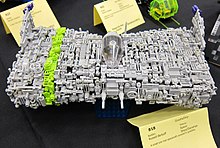Greeble
This article needs additional citations for verification. (January 2010) |



A greeble (/ˈɡriːbliː/ GREE-blee) or nurnie is a prominent detailing added to the surface of a larger object that makes it appear more complex, and therefore more visually interesting. It usually gives the audience an impression of increased scale. The detail can be made from simple geometric primitives (such as cylinders, cubes, and rectangles), or more complex shapes, such as pieces of machinery (cables, tanks, sprockets). Greebles are often present on models or drawings of fictional spacecraft or architectural constructs in science fiction and are used in the movie industry (special effects).
Etymology[]
The earliest recorded use of the term "greeble" found to date was by those working at Industrial Light & Magic for the special effects of Star Wars. They also described this design method as "guts on the outside".
Ron Thornton is widely believed to have coined the term "nurnies" referring to CGI technical detail that his company Foundation Imaging produced for the Babylon 5 series.[1]
In science fiction films and television[]

An early physical example of their application was in the production of the spaceships in 2001: A Space Odyssey (1968) where they were called wiggets.[2]
In physical models, greebles could be anything from parts of plastic cut in interesting shapes, to parts from shop-bought model kits—a method referred to as "kit-bashing". For instance, in Star Wars the original Imperial Star Destroyer was constructed from a plywood frame and adorned with sheet styrene. Panel lines were cut into the styrene, but the ship looked too bare. Hundreds of model kits were purchased, which the model department cut apart and attached, along with more sheet styrene, to the ship's surfaces. These large areas of ancillary details made the ship more believable. The greebles themselves served only to fill space and had no specific functions in the ship's design, although later each of them was given a specific function by fans or technical illustrators for fan guides. A plastic soldier was part of the greebling on the Executor.[3] Star Wars modelers utilized many kits of WWII submarines, whose pipes, cranks and knobs worked well for the exteriors of starships and weapons. When the crew was done they had several submarine hulls left over, some of which were used in the creation of the EF76 Nebulon-B Medical Frigate seen at the end of The Empire Strikes Back. George Lucas said the ship reminded him of an outboard motor.[citation needed]
Another example of greeble application was the Battlestar Galactica model for the original 1970s series, whose hull had pieces from a wide assortment of kits, including Apollo orbiters, Saturn rocket boosters, F-16 fighter jets, and various tanks.

Given its origins, greebling is most often associated with the type of large city-like spaceships made popular in Star Wars, but has been generalized to refer to any dense covering by different (usually mechanical) components. Similarly, Borg starships (and drones) in Star Trek are heavily greebled using leftover sprues from previous kitbashing and photoetched bits.
During production of the first Star Wars movie, Tunisian Customs enquired about a part of C-3PO's costume listed as "assorted greebles". The producers allegedly described it as "something that looks cool but doesn't actually do anything."
Used in interiors[]
Greebles are also used to enhance interior sets. In Star Trek, corridor walls were decorated with interesting-looking bits and pieces. Pieces of pipe poked out of walls, usually with several fittings and a label implying it was an important part of the ship's infrastructure. In the movie Alien, the interior of the ship Nostromo was thoroughly greebled. Art director Roger Christian said, "Let's have a go at it. So we recruited some dressing prop people, got a hold of several tons of scrap, and went to work on the Nostromo's bridge... encrusting the set with pipes and wires and switches and tubing... then we painted it military green and began stenciling labels on everything."[4]
Automated greebling[]

In 3D computer graphics, software can be used to create greeble patterns, making it unnecessary to manually create large assortments of precise custom geometry. This is a process well suited to automatic, software-based procedural generation, particularly if a great degree of control is unnecessary or the greebles are small on-screen. Most greeble-generating software works by subdividing the surface to be greebled into regions, adding some detail to each new surface, then recursively continuing this process on each new surface to some specified level of detail. Similar algorithms are used in the creation of fractal surfaces.
See also[]
References[]
- ^ "Future-Past Interview of Charles Adam quoting Ron Thornton as source of the word 'Nurnies'". Future-past.com. 2008-01-20. Retrieved 2009-11-18.
- ^ "What Are Nurnies". LEde Designs.
One FX group in the UK who built the space ship for “2001: A Space Odyssey” called them wiggets.
- ^ Boiteau, G.; Osborn, W.P.L. (August 1999). "COMPARISON OF PLASTIC-LINED TRENCHES AND EXTRUDED PLASTIC TRAPS FOR CONTROLLING LEPTINOTARSA DECEMLINEATA (COLEOPTERA: CHRYSOMELIDAE)". The Canadian Entomologist. 131 (4): 567–572. doi:10.4039/ent131567-4. ISSN 0008-347X.
- ^ Paul Scanlon; Michael Gross (1979). The Book of Alien. Heavy Metal Books. not numbered; heading on page "It's just a monster of coordination.".
External links[]
- Staffan Norling's comments about greebling
- Starship Modeler: an invaluable resource for science fiction modeling
- buzzGreeble for modo
- Greeble plugin for 3D Studio Max
- Greeble plugin for Realsoft 3D
- Greeble plugin for trueSpace
- Greeble plugin for LightWave
- Greeble script for Blender
- Greeble script for Autodesk Maya
- Greeble script for Cinema 4D
- Computer graphic techniques
- Film and video technology
- Special effects
- Vision
